The iPhone 7 and iPhone 7 Plus Review: Iterating on a Flagship
by Joshua Ho & Brandon Chester on October 10, 2016 8:00 AM EST- Posted in
- Smartphones
- Apple
- Mobile
- iOS
- iOS 10
- iPhone 7
- iPhone 7 Plus
GPU Performance
Section by Brandon Chester
Now that the general system and CPU performance of A10 Fusion has been characterized, we can move on to more focused benchmarks for the GPU and the storage subsystem. Apple's keynote for the iPhone 7 actually disclosed that the GPU in A10 Fusion is a six core part. The last time I recall Apple mentioning specifics about their GPU was with the launch of the iPad 3, where the GPU was advertised as a quad core implementation that turned out to be SGX543MP4.
The use of a six core GPU is interesting because there's not much choice for Apple given that A9 also used the six core PowerVR GT7600. It really boils down to three possibilities. The first is that Apple has actually continued using the exact same GT7600 microarchitecture as on the A9, albeit with an improved layout on the die. The second is that Apple has moved to PowerVR GT7600 Plus, which brings some improvements to integer compute performance, and memory bandwidth optimizations. And the third is the wildcard option - that Apple has put to use its significant GPU engineering resources on a more customized design; something that's still using the PowerVR architecture, but more custom than ever before. This is a longer discussion to have in our full deep dive, but Ryan's of the opinion that this is somewhere between options two and three, that Apple has done some significant work to produce a highly optimized version of the PowerVR GT7600 Plus
In any case, as Apple isn't using a radically different GPU architecture, most of Apple's stated 50% increase in GPU power comes from increasing the clock speeds, with optimizations such as memory and caching picking up the rest. This is interesting because Apple also advertises that A10 Fusion's GPU uses only two thirds the power of A9, which would indicate a lot of work done by Apple to optimize for power usage.


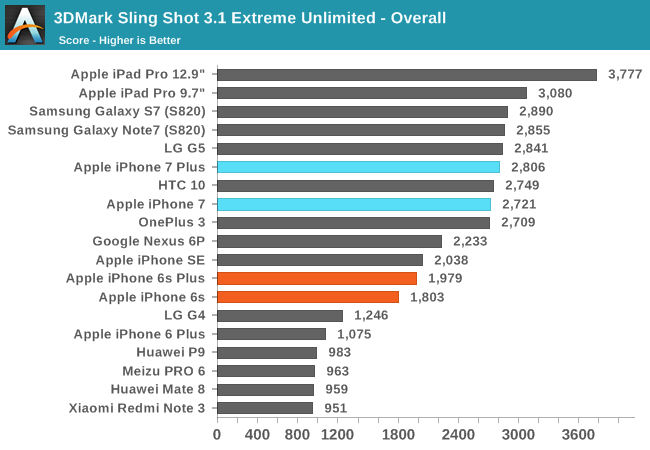
3DMark Sling Shot is broken down into a few different tests, and at the end the results of graphics tests and physics tests produce separate scores which are then used to generate an overall score.
In the graphics test the results are in line with Apple's stated GPU performance improvement of 50%. The physics score, which is really a CPU test, only improves by 30-35%, which has a direct correlation to the increase in peak clock speed from 1.8GHz on A9 to 2.3GHz in A10 fusion.
Like Ice Storm, the physics test is still basically a chart of devices ranked by cores multiplied by max frequency, and you can see that the iPhones have improved very little over the years, with the improvements tracking closely to Apple's increases in CPU clock speed. This comes down to the test being designed in such a way that there's little instruction level parallelism to exploit due to memory dependencies, which puts Apple's wide dual core CPU at a disadvantage. While it is certainly a valid test situation, it's not really reflective of actual 3D game performance because you would generally not write a game in such a way that it cannot exploit the performance of its target hardware.
Even with the smaller improvement in the physics tests, the overall score for the iPhone 7 is still roughly 50% higher than the Apple A9 devices like the iPhone 6s and SE.
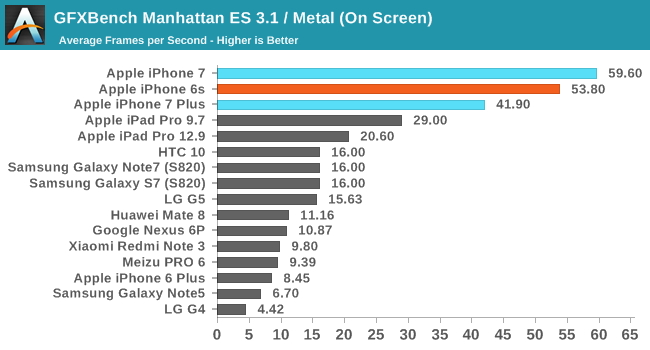
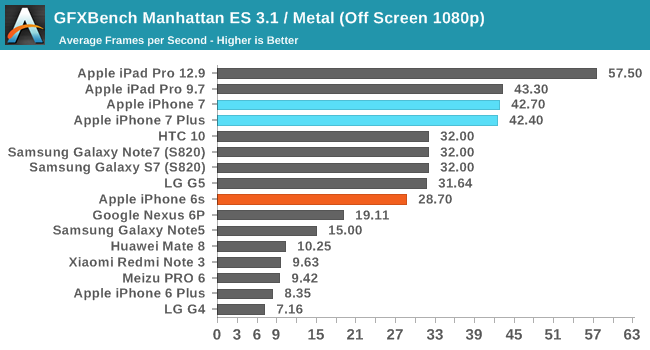
We originally migrated away from Manhattan ES 3.0 to Manhattan ES 3.1 / Metal to push back on devices hitting VSync in the on screen tests. Unfortunately it didn't work for long. With the iPhone 7's increase in GPU performance not being accompanied by an increase in display resolution, the on screen result in GFXBench Manhattan is higher than any other device, and is essentially at the display's refresh limit. The iPhone 7 Plus isn't able to hit Vsync due to its higher resolution, but the on screen result of roughly 42fps is nothing to scoff at either considering the visual complexity of the test.
While on screen performance is helpful from the perspective of someone who wants to see how the phone will actually perform when running a game at its native resolution, to compare directly between devices you need to standardize the rendering resolution. As its name implies, GFXBench's off screen test simply renders all the frames at 1080p in an off screen buffer. In this test the iPhone 7 and 7 Plus both run slightly below 43fps, which puts them right where you'd expect from Apple's claim of 50% greater GPU performance. In GFXBench this also puts the two of them at the same level as the 9.7" iPad Pro for absolute GPU performance.
This gives some interesting insight into the relative clock speeds that Apple is running their GPUs at, as A9X uses a twelve core PowerVR Series7XT GPU, while A10 Fusion uses only six. As I mentioned before, the performance improvements in A10 Fusion primarily come from increasing the peak clock speed. Matching the 9.7" iPad Pro's A9X suggests that Apple has targeted a fairly aggressive clock speed for the GPU in A10 Fusion, and while we can't verify Apple's claim of A10's GPU running at only two thirds the power of A9, if that is indeed the case it would represent a great deal of optimization effort on Apple's part to achieve that despite increasing clock speeds this significantly.
Storage Performance
One of the big changes that came with Apple's A9 and A9X SoCs was a new storage controller designed internally at Apple. This was not the first Apple product to use an in-house SSD controller, as the 2015 MacBook used a PCIe SSD and adopted the NVMe interface. A9 and A9X adapted this for use in mobile, and the sequentual performance in particular was far ahead of anything in a competing mobile device.
Apple hasn't advertised any improvements to storage performance with A10 Fusion, but it's worth running tests to verify that performance has remained at the same level. There are also potential gains in write performance when increasing the total capacity of an SSD by adding additional dies. At this point there's really no benchmark that can give comperable results between iOS and Android, so I've decided against doing a cross-platform comparison here.
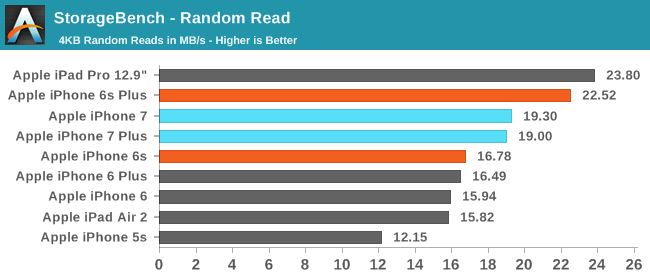
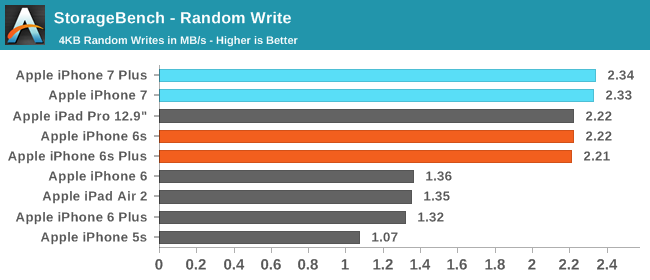

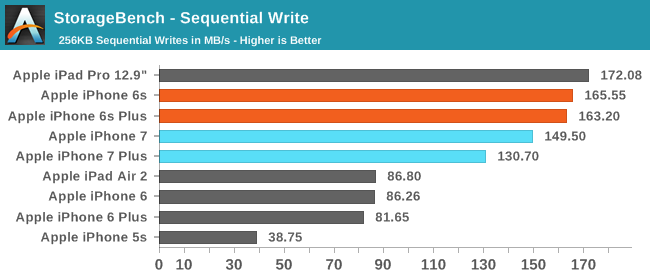
In general, the NAND performance of the iPhone 7 and 7 Plus is equivalent to the iPhone 6s and 6s Plus. There are some minor differences, but essentially all of them can be attributed to testing variance. The only thing that is worth noting is that there's no significant improvement to write performance even though the iPhone 7 units tested are 256GB models while the 6s and 6s Plus were 128GB models. This suggests that the NAND packages use higher capacity dies so there's no additional parallelism to take advantage of.










377 Comments
View All Comments
MykeM - Tuesday, October 11, 2016 - link
He's probably referring to the Galaxy S6 Edge which is 0.1mm thicker than the iPhone 6 (7mm vs 6.9mm).doubledeej - Monday, October 10, 2016 - link
It's hard to take the article seriously when it says that the removal of the headphone jack "doesn't really matter." There are a ton of users out there that are completely unsatisfied with the terrible sound quality of the included headphones, and the AirPods are no better. And there are other issues as well.Those interested in high quality sound, who are the most invested in actually wanting a headphone jack, will have better quality headphones they'll want to use. (I, for example, have never removed the EarPods from the iPhone box.) Yes, Apple includes an adapter (gag!), but that's just one more thing we'll forget to bring with us when we leave home, or to get lost and have to be replaced. Adapters are a horrible solution.
It's even worse for those of us that actually connect our phones into high quality audio systems. Again, we're stuck (or in my case, would be stuck) with using an adapter, and not being able to charge the phone at the same time.
Wireless is NOT the same thing. Wireless sound quality always suffers. And having to remember to charge one more device, and worry about one more battery wearing out, just isn't an acceptable solution. Not to mention that you can't use wireless headphones on an airplane.
Apple's decision to remove the headphone jack was just dumb. I, for one, have forgone getting the iPhone 7 specifically for that reason, even though I've purchased every other model since it became available on my carrier. And unless the headphone jack returns, the 6S will be my last.
Some will argue that "wireless is the future" but it's a mediocre substitute at best for a reliable, simple connection that has been proven over time. Simple is a good thing. It means it just works. Some may call the headphone jack a relic, but we use old relics of technology all of the time. Being old doesn't make it bad. The wheel, for example, has been around for millennia, but you don't really see very many people pushing to replace it with something else. Wireless headphones are far more complicated: encoder -> transmitter -> antenna -> antenna -> receiver -> decoder -> analog conversion -> amplifier -> headphone instead of digital -> analog conversion -> amplifier -> headphone.
eastpoint - Tuesday, October 11, 2016 - link
i love hifi audio and i have a pretty nice set of cans i paid a pretty penny for. I have so far left the adapter connected to my headphones without problem. why? because its fundamentally something i have to have a wired connected to anyway so its no big deal. i also purchased an additional adapter for my home setup and left it connected to that as well. sure i could sit and complain about it but the solution is simple enough and low cost enough that its no big deal. I could have complained more but it came with a free one in box so it left me actually losing no functionality with purchase so to me its beating a dead horse over nothing. You may not like the solution but there is one and its a really simple one at that.ACM.1899 - Thursday, October 13, 2016 - link
they removed the 3.5mm jack and what did they add instead? at least a built in dac (like HTC 10, v10 or v20) would have been nice.i've heard the sound through the dongle isn't as good as previous.
or bluetooth headphones (in general) are not as good as analog headphones (with the same price).
and i know it's a smartphone, not a pro music player.
every time Apple does something stupid we say it's because of this
or that
or it's a dead horse
or for that you can do this
or it's the future....
but WHY?
for now the only (main) reason is marketing.(Apple & Beats)
it looks like we are buying a better iPhone with the same price as before but after a year (or 6 months) you'll be forced to buy another dongle or BT headphone , even then you'll still think that you bought a better phone, and that's sad...
as long as a good BT headphone is not the same price as a good analog headphone , i don't want them.
until then the 3.5mm jack should have not been removed.
at least i don't need that bs taptic engine...
Constructor - Monday, October 17, 2016 - link
It's rather simple, and very likely exactly what they've been saying all along: To make room for other components, such as the bigger camera, the bigger battery, the bigger Taptic Engine and apparently also the pressure interface for the barometer.Engineering is always a matter of compromises, and in a smartphone size, weight and battery life make all compromises difficult to reconcile. And in the fight for future improvements the built-in headphone jack got kicked to the curb to allow for the other improvements.
Any develpper worth their salt knows these kinds of decisions from experience, and users waffling on about "marketing" or "greed" almost always have us roll our eyes. Developing complex machinery is a tough business and not for the faint of heart; Very few manufacturers allow their developers to pursue new opportunities as ruthlessly as Apple does. And so far they've got a pretty good track record of mostly being right in hindsight (although some people still keep moaning about the buil-in serial ports or floppy drives of old).
Dbarua - Monday, October 10, 2016 - link
AIDA reports the gpu is the power vr 7XT 7600 6 cores. That would make it the same as the iPad pro with half the number of clusters. Also as expected I have a model 1784 and the modem is a n Intel 7360Ryan Smith - Tuesday, October 11, 2016 - link
For what it's worth, AIDA is just guessing. It's not like on the PC where you can poke registers and get a definitive result, rather the program is just querying its database. It's an educated guess, but reality is a bit more nuanced than simply calling it Series 7XT.just4U - Tuesday, October 11, 2016 - link
I've read every single iPhone review by Anandtech thru the years.. and never owned one. I've used others briefly but never found anything interesting enough to bite the bullet and get one for myself. Maybe it's a question of what your used to?I went from a Mike Phone (work) to a blackberry to S2, S4, and S6. Course I also owned a brick!! back in the early 90s but that's neither here nor there..
Code.Red - Tuesday, October 11, 2016 - link
I have the iPhone 7 and noticed the animation stuttering issue when closing apps as well, but am struggling to understand the explanation given for it in the article. The iPhone 6 and 6S do not stutter in the same animation on iOS 10, so why does the new home button make a difference there? I can press the 6S' physical button and the 7's solid state button at the same rate and the same timing, so what about having a solid state button changes the way the animation works?UtilityMax - Wednesday, October 12, 2016 - link
I think the iPhones were truly interesting in their earlier years, when their iOS was vastly superior to a repetitively chaotic android that was still playing a catch up. However, around 2012-2013 the convergence of the OSes was pretty close, and the Android hardware made a massive leap by introducing large screen smartphones while Apple continued being stuck with relatively small iphones until iPhone 6.